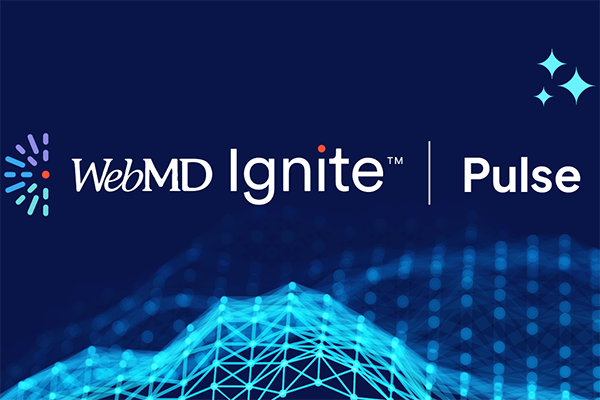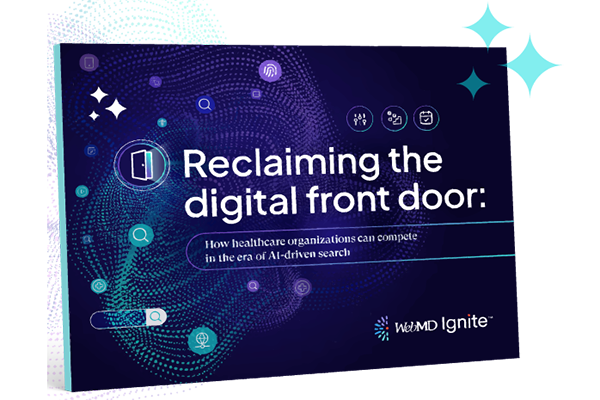Personalize Your Healthcare Website for Patient Satisfaction

Categories: health plans, health systems, healthcare organizations, associations
Editor's Note: This blog was published prior to the transition to WebMD Ignite.
From social media to mobile connectivity, patients have more ways to engage online than ever before. One of the most groundbreaking innovations in the digital space, however, is personalization.
When a patient visits your website, they expect to see information that is relevant to their health needs and interests. This isn’t an easy task. Creating a message that resonates with a diverse range of patients can seem difficult, if not impossible.
Website personalization simplifies this process. It allows healthcare marketers to curate a dynamic web experience for each visitor based on patient and consumer data, helping you reach patients with the exact message they need to hear.
With the right strategy and technology, you can boost patient engagement and encourage patient acquisition. Let’s take a closer look at how to enable your own healthcare website.
What is website personalization?
Website personalization lets you show different information to each of your visitors based on data collected from previous interactions. For healthcare organizations, this often means identifying a customer or patient’s health needs and providing outreach on those insights.
To get started, you need information about your users, including their health needs, interests, preferences, and demographics. You could collect this information explicitly (like asking a patient to disclose their location) or harness the patient and consumer data your health system collects every day. Then, you can use technological and strategic solutions to turn that raw data into important patient insights. From there, you only need to align the patient’s online experience with that information.
Why is website personalization important for healthcare?
Website personalization helps patients and visitors find relevant information, products, and services quickly. This improves their experience in two primary ways:
Speed — If patients can’t quickly find what they’re looking for on your website, they’ll look elsewhere. Providing a personalized pathway links them to their desired information or service quicker, meaning that they’re more likely to convert and return to your website in the future.
Relevance — When a patient searches for information about their health, they don’t want to be bombarded by services or content that are irrelevant to them — it’s frustrating. With website personalization, you can insert dynamic, relevant calls-to-action (CTAs) that directly address the patient’s needs.
Think about how important it is for your physicians to provide a unique experience for each patient. People appreciate doctors who reference their care history and remember previous discussions, so they don’t have to repeat themselves again and again. If a patient needs to explain aspects of their medical history several times in a single visit, they won’t feel listened to or cared for.
The same goes for your website. If the patient's online experience includes relevant information about their health, they’ll have a more streamlined experience that leaves them feeling valued.
Benefits of website personalization in healthcare
Website personalization gives you the ability to tailor information toward your audience, which imparts many benefits. Here are a few ways that website personalization benefits health systems:
- Changing health consumer attitudes towards healthcare
- Boost revenue for your health organization
- More relevant engagement, leading to increased acquisition and conversions
- Brand reputation management
Tips to enable website personalization in healthcare
Website personalization isn’t a light undertaking. It requires plenty of data, cutting-edge healthcare specific tools, and a well-crafted strategy. Here are a few tips to help you start your strategy on the right foot.
Collect important data
The first step to successful personalization in healthcare is data collection. You should gather pertinent information about prospective new patients as well as existing patients, like:
- Which channels are attracting visitors (i.e., social media, display ads, search)?
- What search terms are driving them to your website?
- Which page do they land on, and which pages do they visit next?
- Where are they geographically located?
- What services do they need from you?
- When are they most active on your site?
- Have they signed up for any events or downloaded any content?
And that’s only the beginning. So long as the data isn’t considered protected health information, there is almost limitless opportunity to collect and use patient data, since health systems collect large quantities of data during their day-to-day operations.
Create patient personas
Once you’ve collected the right information about your users, it’s time to create patient personas. A persona is an imaginary version of your target customer, designed to help you with segmenting audiences and curating content. It takes into account data about their previous searches, interests, attributes, and more. Then, it offers up the services and content that they’re most likely to want in the future. This is the trick to providing highly relevant and personalized content.
Find healthcare-specific tools
When it comes to using patient and consumer data to your advantage, you’ll need tools and services catered to the healthcare industry. For example:
- A curated data network that provides high-quality data from healthcare consumers.
- Technical and strategic solutions to help you turn datasets into actionable insights.
- Activation solutions to help you carry out your campaigns in an effective manner.
With these three technologies combined, you can deliver relevant recommendations and a top-of-the-line patient experience on your healthcare website.
Use implicit personalization
Implicit personalization is the use of information gleaned from tracking the patient as they use your website. This information includes how they arrived at your website, what pages they visited, how long they stayed onsite, and where they are from geographically. This is what many people think of when they hear “personalization.” It has the advantage of subtly guiding patients through their journey without requiring any input. In fact, visitors may not even realize their online experience has been personalized with implicit personalization. The result is a seamless, streamlined online experience.
Use explicit personalization
Explicit personalization is when you directly ask your users what kind of personalized experience they’re looking for. This could appear as a form when they visit your website that asks what services they need, or what they’d like to appear on the homepage. This way, the user is taken directly to the page they’re looking for.
Utilizing explicit personalization can be highly effective as it can be perceived as less intrusive than implicit personalization. Some health systems may prefer to start off offering explicit personalization options, then weave in implicit personalization as they gain better control over their data.
Restrictions and ethical considerations
Before you kick off your website personalization strategy, it’s important to ensure your campaign follows both legal and ethical guidelines. Otherwise, your personalization initiative may hinder more than it helps.
Legal considerations
There are several regulatory and ethical considerations when it comes to data collection and use — especially in healthcare.
Ensuring HIPAA compliance is the number one concern for healthcare marketers. For instance, healthcare marketers can only use patient information for marketing purposes under very specific circumstances, leading to hesitation. Further, additional data security measures are often required for the sensitive information collected about patients.
Navigating the legal requirements of data collection and use in the healthcare sector can be incredibly difficult. Working with an experienced healthcare marketing agency alongside healthcare specific tools will help you achieve the best possible outcomes while ensuring regulatory compliance.
Ethical considerations
With smartphones, websites, and apps constantly collecting data, people are more concerned about privacy than ever before. For this reason, it’s important not to go too far when collecting and utilizing data from your patients and users.
Patients want easy access to relevant information when they visit your website. But they do not want to feel like the collection of data is an intrusion on their privacy, especially when it comes to highly sensitive health information.
For example, implementing a CTA that encourages patients with a history of knee pain to schedule an appointment with an orthopedist is unlikely to raise any alarm. On the other hand, directly asking the patient to take care of their lingering knee pain might be seen as an invasion of privacy. Keep this in mind when leveraging consumer insights to ensure the comfort of your patients.
The power of personalization
Website personalization helps you target patients and consumers with relevant, contextual information about their health. It is a cost-effective way to improve engagement, reach and trust, drive conversions, and improve loyalty in your brand. In the end, it will give you a massive upper hand when it comes to standing out in a competitive marketplace.




